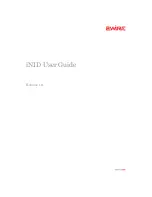
AM64/128A User Manual
Appendix C - In Service Test
A-9
It must be remembered that this error count is unidirectional only. There can be no looping of the envelope
alignment bits. This fact can be used to advantage in determining the location of noise on a link. Consider
an example where two BBM’s are connected together. BBM1 indicates a high error rate, and BBM2
indicates a low error rate. It can then be inferred that the noise is worse close to BBM1, (Noise has the
greatest effect where the signal is weakest, the signal from BBM2 is weak at BBM1. The noise has little
effect on the transmitted signal from BBM1, and hence the signal arriving at BBM2 is error free).
The use of alignment bits for error monitoring is the prefered use of In Service Testing, however there are
several user rates where this method will not work (because there are no alignment bits transmitted in the
frame structure, see previous section).
The comms channel error monitoring can be used at all line rates. The disadvantage of using this technique
however, is that the ratio of comms bits monitored to data bits is low; i.e. error rates have to be high, or
tests have to be very long, to accumulate any significant data.
Only one of the four comms bits per frame forms part of a 8 bit multi frame word, (the comms framing
word) which can be monitored for errors. This gives the equation for the bit error rate to be:
Comms Error Rate x 108
Bit Error Rate (BER) = _____________________
User Data Rate x Time
There is a complication with the comms framing word.The word is originally transmitted from the master
BBM; when it gets to the slave it is monitored for errors, and then re-transmitted (in its errored form) back
to the master. The comms error display has thus a different meaning on the master and on the slave. The
master display is the error count around the loop, and the slave display is the error count in the single
direction only.
There is a further method of error monitoring that is included in the master BBM only. These errors are
termed ‘Transmitted envelope errors’. This technique can allow the master BBM to determine the location
of noise on the line, with no help from the slave display. It is thus useful if access to the slave is difficult or
inconvenient. The envelope alignment errors counted by the slave is encoded into the comms channel and
sent to the master. As the ratio of comms bits to envelope bits is fairly low, and provided the over all error
rate is fairly low (not many comms errors, i.e. bit error rate less than 10
-3
), the master can expect to receive
a reasonable account of the envelope alignment errors as counted by the slave. The master BBM then has
available (1) the envelope alignment errors that it has received, and (2) the envelope alignment errors that
the slave has received. The relative performance of either end of the link can thus be determined. It should
be stressed that this error information in the comms channel is obviously subject to error itself and so
accuracy is very limited with short tests and high error rates.








































